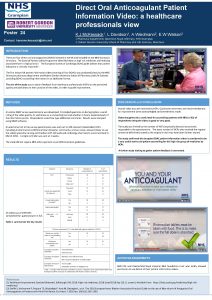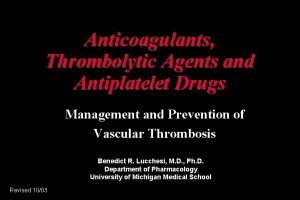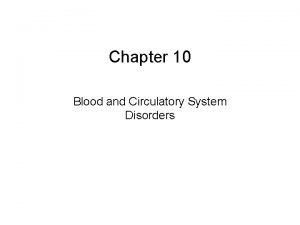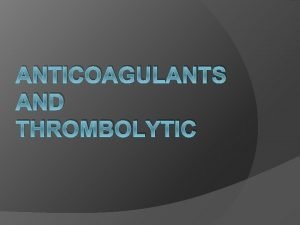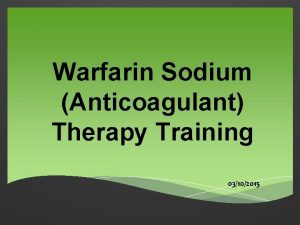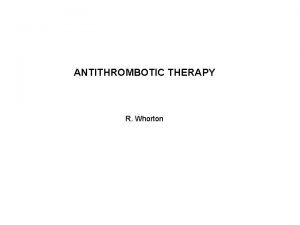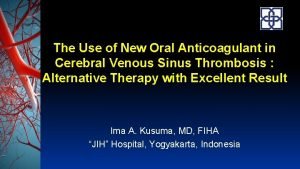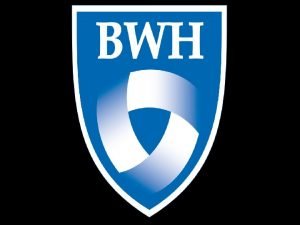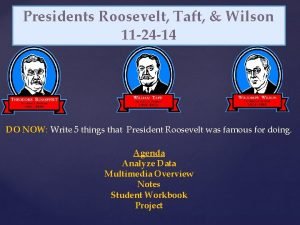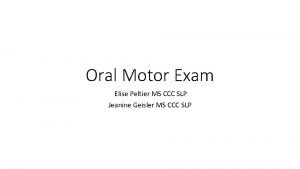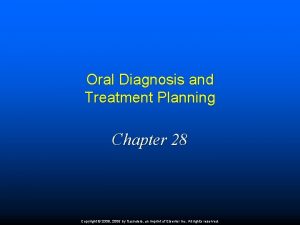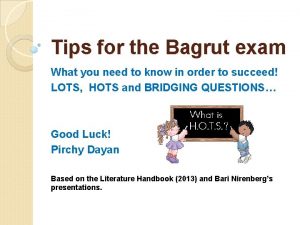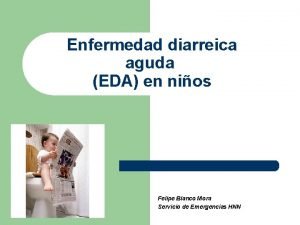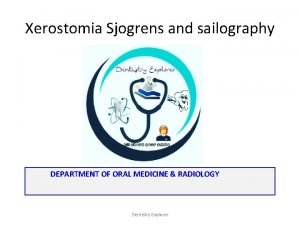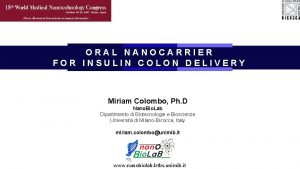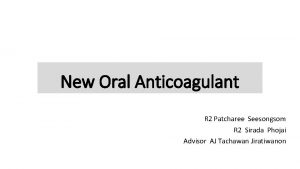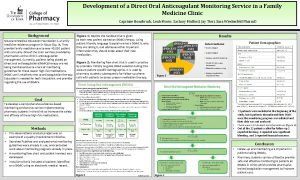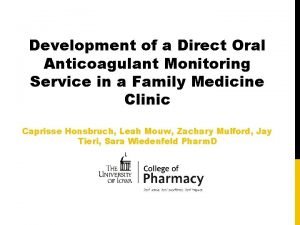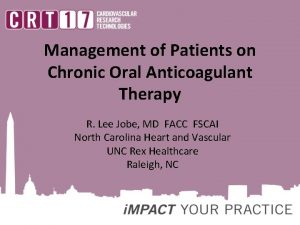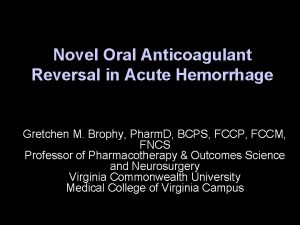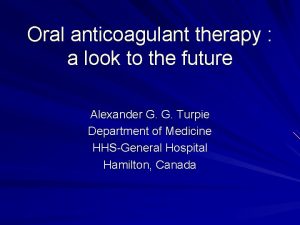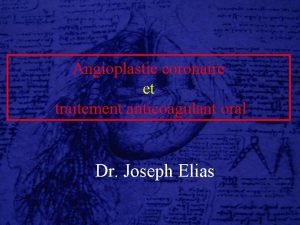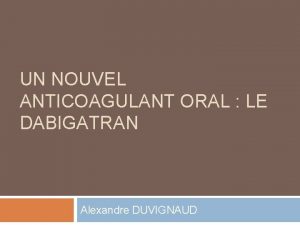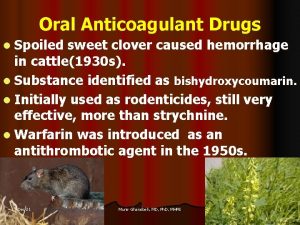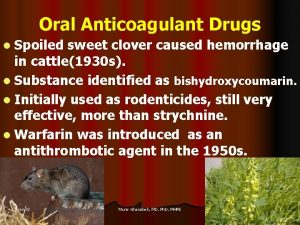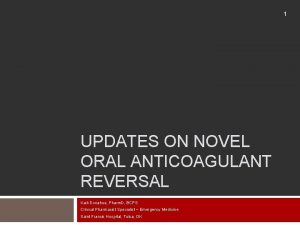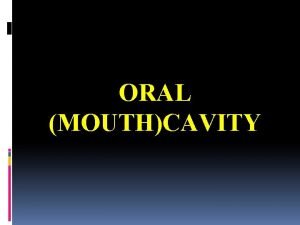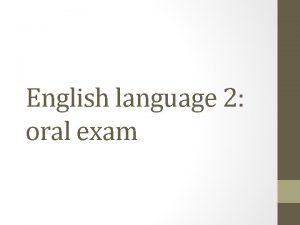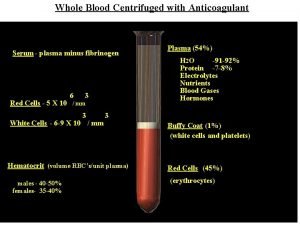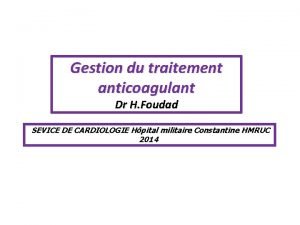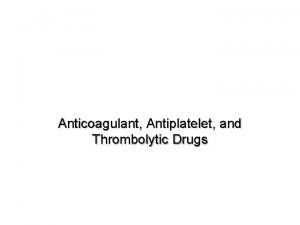New Oral Anticoagulant s the Who What When






































































- Slides: 70

New Oral Anticoagulant s – the “Who, What, When & How” Dr. Farooq Faheem

• Importance of stroke prevention in NV-AF patients • ✤ Overview of new treatments available • ✤ Efficacy, clinical & safety data • ✤ Treatment pathways and guidelines (BNSSG) • & • REAL LIFE CASES

Mr. M. R. 62 Years of age Lives alone Single

Past History • 1998: Diabetes • 2004 : Presented with ataxia confusion and headaches ? Cause • 2007: Slurred speech and confusion : Put down to alcohol intoxification • August 2011: Slurred speech, facial drop AF and diagnosed with TIA/CVA and warfarinised

Background Smokes 20 + cpd (mixture of tobacco and cigarettes) Alcohol up to 2 - 3 bottles of cider per day Hypertension Echocardiogram: Severe LV dysfunction & Biatrial dilatation COPD with frequent exacerbations

Background Lives alone approx. 3 miles from the practice No transport Never married Not worked since 1998 One sister in Weston 8 miles away

Progress • From Sept 2011 to February 2012: did very well with INR testing • • 20 x INR tests between March 12 to Aug 2012 • Average INR 6. 3 (Venous 8. 9) • ? Back to drinking heavily

Progress Discussed at Partner’s meeting following complaints from District Nurses about his: FEROCIOUS…………. .

NO MORE EXCUSES

Discussions • Actual visits were twice as many according to District nurses • Would not wake up until late afternoon. • DN unable to get access to the house. • Substantial risk of falls

Started on NOAC November 2012 • Added to his Dosette Box • Happy District Nurses! • Latest audit: No blood samples taken as unable to get access to his house

One has to do what one has to do!

Mrs. D. W. 82 Years of age Lives alone

Background • Active extremely well and totally asymptomatic • Hypertension 2006. Ramipril was prescribed. • She never took it! • December 2010: near fainting and speech slurred and vacant for approx. 30 minutes

Background Never Smoked Alcohol : One/Two units per Year! Hypertension Grows almost all of her vegetables. Extremely active Large Family scattered around the UK and the world (Son in Canada, Daughter in France)

July 2012 –Presented with SOBOE –She put it down to gaining a bit of weight –All baseline bloods normal –CXR: Normal

ECG

Progress • Explained: Very skeptical • Wanted to check herself : ON THE INTERNET! • To discuss with her family • Leaflet for warfarin and NOACs

Progress • Flatly refused to take warfarin • Most of her diet was from her home grown vegetables • Started on NOAC

One week later….


A Worried Doctor! • TOTALLY CHILLED PATIENT! • Asked her to stop medication and return a week later to discuss warfarin AGAIN!

No show…. . • FOUR WEEKS LATER: • WANTED REPEAT PRESCRIPTION FOR…. .

What happened? • PRESENTED TO EYE CASUALTY AT BRISTOL EYE HOSPITAL THE SAME EVENING…. as did not trust my advice! • OPHTALMOLOGIST REASSURED HER: MINOR BRUISING: No long-term consequences • THEY SUGGESTED SHE CONTINUES

A VERY RELIEVED DOCTOR INDEED!


Patients with AF have an approximately fivefold increased risk of ischaemic stroke 1 Framingham Heart Study (N=5, 070) 2 -year age-adjusted incidence of stroke/1, 000 60 Risk ratio=4. 8 p<0. 001 50 40 30 *Patients were seldom treated with antithrombotic therapy when this study was performed in line with clinical practice at the time 20 10 0 Individuals without AF 1. Adapted from Wolf PA et al. Stroke 1991; 22: 983– 988 Individuals with AF*

fine 4 fit. blogspot. com

ANIMATION

AF-related stroke can be preventable • By preventing thrombus formation in the heart (thrombo-prophylaxis) • Why Aspirin does not work?

Many Factors Elevate AF Stroke Risk CHADS 2 score Risk factor Congestive heart failure/LV dysfunction Annual Risk of Stroke Points +1 CHADS 2 Stroke Score Risk % 95% CI 0 1. 9 1. 2– 3. 0 1 2. 8 2. 0– 3. 8 2 4. 0 3. 1– 5. 1 3 5. 9 4. 6– 7. 3 Hypertension +1 Age ≥ 75 years +1 Diabetes mellitus +1 4 8. 5 6. 3– 11. 1 Stroke/TIA/TE +2 5 12. 5 8. 2– 17. 5 6 18. 2 10. 5– 27. 4 Cumulative score Range 0− 6 Score: 0 = low risk; 1 = intermediate risk; ≥ 2 = high risk Gage Bet al. Circulation 2004; 110: 2287 -2292

The CHADS 2 index has been routinely used as an initial, rapid, and easy-to-remember means of assessing stroke risk 1– 4 CHADS 2 criteria Score Congestive HF 1 CHADS 2 Adjusted stroke rate* (95% CI) 6 18. 2 (10. 5 to 27. 4) 5 12. 5 (8. 2 to 17. 5) 4 8. 5 (6. 3 to 11. 1) 3 5. 9 (4. 6 to 7. 3) Patients (%) 36. 1% Hypertension 1 Age ≥ 75 years 1 Diabetes 1 2 4. 0 (3. 1 to 5. 1) 30. 1% Stroke or TIA (previous history) 2 1 2. 8 (2. 0 to 3. 8) 27% 0 1. 9 (1. 2 to 3. 0) 6. 9% Sum 33. 6% with CHADS 2 0 or 1 *Adjusted stroke rate = expected stroke rate per 100 patient-years from exponential survival model, assuming ASA not taken 1. Gage et al. JAMA 2001; 285: 2864– 2870 2. Gage et al. Circulation 2004; 110: 2287– 2292 3. Camm et al. Eur Heart J 2010; 31: 2369– 2429 4. Nieuwlaat et al. Eur Heart J 2006; 27: 3018– 3026 Date of Preparation: October 2013. 432 UK 13 PR 10268 -01. Not for further distribution. 32

The CHA 2 DS 2 -VASc scheme was adopted by the ESC to complement the CHADS 2 scoring system CHADS 2 Score CHA 2 DS 2 -VASc Score Congestive heart failure 1 Congestive heart failure/left ventricular dysfunction 1 Hypertension 1 Aged ≥ 75 years 2 Diabetes mellitus 1 Diabetes mellitus 1 Stroke/TIA/TE 2 Stroke/TIA/TE 2 Maximum score 6 Vascular disease (prior MI, PAD, or aortic plaque) 1 Aged 65– 74 years 1 Sex category (i. e. female gender) 1 Maximum score 9 Camm et al. Eur Heart J 2010; 31: 2369– 429. CHA 2 DS 2 -VASc: 4 In patients with a CHADS 2 score of 0– 1, or 4 When a more detailed stroke risk assessment is indicated Date of Preparation: October 2013. 432 UK 13 PR 10268 -01. Not for further distribution. 33

CHA 2 DS 2 - VASc Risk Scoring for AF patients and Thromboprophylaxis Guidelines (ESC)1 Score 0 1 Risk Low Moderate 2 or more Moderate High 1. Camm et al, 2010 Considerations Aspirin daily or no antithrombotic therapy No antithrombotic therapy preferred Either; oral anticoagulant (e. g. well controlled warfarin or NOACs) or Aspirin daily / Oral anticoagulant (e. g. well controlled warfarin or NOACs)

The 2010/2012 ESC guidelines recommend the use of a simple bleeding risk score: HAS-BLED Letter Clinical characteristic Points awarded H Hypertension 1 A Abnormal renal and liver function (1 point each) S Stroke 1 B Bleeding 1 L Labile INRs 1 E Elderly (e. g. age >65 years) 1 D Drugs or alcohol (1 point each) 1 or 2 Maximum 9 points HAS-BLED ≥ 3: 4 Indicates ”high risk”, and 4 Some caution and regular review of the patient is needed following the initiation of antithrombotic therapy, whether with OAC or aspirin 35

CHADS 2 and CHA 2 DS 2 -VASc both available in GRASP-AF Risk factor Points Congestive heart failure/LV dysfunction +1 Hypertension +1 Age ≥ 75 years +2 Diabetes mellitus +1 Stroke/TIA/TE +2 Vascular disease (MI, aortic plaque, PAD)* +1 Age 65– 74 years +1 Sex category (female) +1 Cumulative score http: //www. improvement. nhs. uk/graspaf/- accessed 07/09/2012 Range 0− 9

ESC 2012 recommendations – risk assessment Recommendations Class Level The CHA 2 DS 2 -VASc score is recommended as a means of assessing stroke risk in non-valvular AF. I A Assessment of the risk of bleeding is recommended when prescribing antithrombotic therapy (whether with VKA, NOAC, ASA/clopidogrel, or ASA). I A IIa A The HAS-BLED score should be considered as a calculation to assess bleeding risk, whereby a score ≥ 3 indicates ‘high risk’. Camm et al. Eur Heart J 2012; e-published August 2012, doi: 10. 1093/eurheartj/ehs 253. Date of Preparation: October 2013. 432 UK 13 PR 10268 -01. Not for further distribution. 37

ESC 2012 recommendations – antithrombotic therapy Recommendations Class Level Antithrombotic therapy to prevent thromboembolism is recommended for all patients with AF, except in those patients (both male and female) who are at low risk (aged <65 years and lone AF), or with contraindications. I A The choice of antithrombotic therapy should be based upon the absolute risks of stroke / thromboembolism and bleeding and the net clinical benefit for a given patient. I A IIa B When patients refuse the use of any OAC (whether VKAs or NOACs), antiplatelet therapy should be considered, using combination therapy with aspirin 75– 100 mg plus clopidogrel 75 mg daily (where there is a low risk of bleeding) or – less effectively – aspirin 75– 325 mg daily. Camm et al. Eur Heart J 2012; e-published August 2012, doi: 10. 1093/eurheartj/ehs 253. Date of Preparation: October 2013. 432 UK 13 PR 10268 -01. Not for further distribution. 38

Traditional anticoagulants: drawbacks • UFH 1 – Parenteral administration – Monitoring and dose adjustment required – Risk of HIT • LMWH 1 – Parenteral administration – Weight-adjusted dosing (for obese patients 1. Hirsh J et al. Chest 2008; 133; 141 S– 159 S 2. Ansell J et al. Chest 2008; 133; 160 S– 198 S 1. Hirsh J et al. Chest 2008; 133; 141 S– 159 S; 2. Ansell J et • Oral VKAs 2 – Narrow therapeutic window – Interaction with food and drugs – Frequent monitoring and dose adjustment required al. Chest 2008; 133; 160 S– 198 S

Coagulation pathway VII TF VIIa VKA Initiation IX X Propagatio n VKA Xa Inactive Factor IXa Active Factor Direct Factor Xa inhibition II Rivaroxaban Direct Factor IIa inhibition Dabigatran Fibrinogen IIa Prothrombi n Thrombin Fibrin Spyropoulos AC et al. Expert Opin Investig Drugs 2007; 16: 431– 440 (adapted from) Transformation Catalysis

Oral anti-coagulation is shown to be effective for stroke prevention in AF Reduction of risk of thromboembolism in AF 1 Study, year Relative risk reduction (95% CI) Absolute risk reduction AFASAK I, 1989; 1990 2. 6% 4. 7% SPAF I, 1991 2. 4% BAATAF, 1991 1. 2% CAFA, 1991 3. 3% 8. 4% SPINAF, 1992 EAFT, 1993 All trials (n=6) primary prevention 2. 7, secondary prevention 8. 4 100% 50% Favours VKA Hart RG et al. Ann Intern Med 2007; 146: 857– 867 0 – 50% Favours placebo – 100%

Limitations of Warfarin Therapy in AF Unpredictable response Narrow therapeutic window (INR range 2 -3) Need for coagulation monitoring Warfarin therapy has several limitations that make it difficult to use in practice Frequent dose adjustments Warfarin was #1 in 2003 and 2004 in the number of mentions of “deaths for drugs causing adverse effects in therapeutic use” n J Thrombolysis 2008; 25: 52 -60 Slow onset/offset of action Numerous food-drug interactions Numerous drug-drug interactions s e ch a pro rsal Risk of bleeding p a ve d e complications sh ent re i l tab urg s E for

Narrow Therapeutic Window Target INR (2. 0 -3. 0) 80 Events / 1000 patient years Ischaemic stroke Intracranial haemorrhage The therapeutic effect of vitamin K antagonists is optimized when the INR is maintained within a narrow range 60 40 20 0 <1. 5 N Engl J Med 2003; 349: 1019 -26 1. 5– 1. 9 2. 0– 2. 5 2. 6– 3. 0 3. 1– 3. 5 3. 6 -4. 0 International Normalised Ratio (INR) 4. 1 -4. 5 >4. 5

Drug and food interactions with warfarin

Reasons for warfarin omission Bleeding Risk (23. 5%) Physician Judgement (50. 4%) Patient Preference (26. 1%) “Not Willing To Take VKA” N Engl J Med 2009; 360: 2066 -78 Another 22. 8% “Not Willing To Take VKA”

Ideal Anticoagulant? Easily No routine Wide Adaptable for Once No Food Predictable coagulation Fixed therapeutic compliance daily Interactions response monitoring dosing window aids OPTIMAL 1 Warfarin 1, 2 NOACs +/- Taken with food 1. Perzborn et al. Drug discovery 2011 10: 65 -71 2. Warfarin 0. 5 mg SMPC 2010 3. Xarelto Sm. PC June 2012

SPAF trials versus warfarin Dabigatran 1 -3 Rivaroxaban 4, 5 Apixaban 6, 7 Study RE-LY ROCKET-AF ARISTOTLE Design PROBE Double Blind Follow up 2 yrs 1. 5 yrs Population size >18, 000 >14, 000 >18, 000 Inclusion Nonvalvular AF + 1 risk factor Nonvalvular AF + 2 risk factors (i. e. moderate to high risk) Nonvalvular AF + 1 risk factor Inclusion (CHADS) 2. 1 3. 5 2. 1 Primary Endpoint Stroke and systemic embolism Warfarin comparator INR control (mean TTR) 64% 55% 62% PROBE = prospective randomised open blinded end-point; INR = international normalised ratio; TTR = time in therapeutic range Clinical Trial Data for information only - no clinical conclusions should be drawn. Please refer to individual product SPCs for further information. 1. Ezekowitz MD et al. Am Heart J 2009; 157: 805– 10; 2. Connolly SJ et al. N Engl J Med 2009; 361: 1139– 51; 3. Connolly SJ et al. N Engl J Med 2010; 363: 1875– 1876; 4. Rocket Investigators. Am Heart J 2010; 159: 340 -347; 5. Patel MR et al. NEJM 2011; 365: 883– 91; 6. Lopes et al. Am Heart J 2010; 159: 331 -9; 7. Granger et al. N Eng J Med 2011; 365: 981 -92.

New agents: Stroke, systemic embolism vs warfarin %/yr Warfarin %/yr HR (95% CI) Dabigatran 150 mg 1. 11 1. 71 0. 65 (0. 52 -0. 81) Dabigatran 110 mg 1. 54 1. 71 0. 90 (0. 74 -1. 10) Rivaroxaban 2. 1 2. 4 0. 88 (0. 75 -1. 03) Apixaban 1. 27 1. 60 0. 79 (0. 66 -0. 95) SSE vs warfarin (ITT population) SSE = stroke and systemic embolism 0. 5 1 1. 5 Favours new orals Favours warfarin Clinical Trial Data for information only - no clinical conclusions should be drawn. Please refer to individual product SPCs for further information. 1. Connolly SJ et al. N Engl J Med 2009; 361: 1139– 51; 2. Connolly SJ et al. N Engl J Med 2010; 363: 1875– 1876; 3. Patel MR et al. NEJM 2011; 365: 883– 91 and Supplementary Appendix; 4. Granger et al. N Eng J Med 2011; 365: 981 -92.

New agents: Ischaemic stroke vs warfarin HR (95% CI) Ischaemic stroke vs warfarin %/yr Warfarin Dabigatran 150 mg 0. 86 1. 14 0. 75 (0. 580. 97) Dabigatran 110 mg 1. 28 1. 14 1. 13 (0. 891. 42) Rivaroxaban 1. 34 1. 42 0. 94 (0. 751. 17) Apixaban* 0. 97 1. 05 0. 92 (0. 741. 13) *Ischaemic or uncertain type of stroke %/yr 0. 5 1 Favours new orals Favours warfarin Clinical Trial Data for information only - no clinical conclusions should be drawn. Please refer to individual product SPCs for further information. 1. Connolly SJ et al. N Engl J Med 2009; 361: 1139– 51; 2. Connolly SJ et al. N Engl J Med 2010; 363: 1875– 1876; 3. Patel MR et al. NEJM 2011; 365: 883– 91 and Supplementary Appendix; 4. Granger et al. N Eng J Med 2011; 365: 981 -92. 1. 5

New agents: Haemorrhagic stroke vs warfarin %/yr Warfarin %/yr HR (95% CI) Dabigatran 150 mg 0. 10 0. 38 0. 26 (0. 14 -0. 49) Dabigatran 110 mg 0. 12 0. 38 0. 31 (0. 17 -0. 56) Rivaroxaban 0. 26 0. 44 0. 59 (0. 37 -0. 93) Apixaban 0. 24 0. 47 0. 51 (0. 35 -0. 75) 0 1 Favours new orals Favours warfarin 1. Connolly SJ et al. N Engl J Med 2009; 361: 1139– 51; 2. Connolly SJ et al. N Engl J Med 2010; 363: 1875– 1876; 3. Patel MR et al. NEJM 2011; 365: 883– 91 and Supplementary Appendix; 4. Granger et al. N Eng J Med 2011; 365: 981 -92. 2. 0

New agents: Intracranial bleeding vs warfarin %/yr Dabigatran 150 mg Warfarin %/yr HR (95% CI) 0. 32 0. 76 0. 41 (0. 28 -0. 60) Dabigatran 110 mg 0. 23 0. 76 0. 30 (0. 19 -0. 45) Rivaroxaban 0. 5 0. 7 0. 67 (0. 47 -0. 93) Apixaban 0. 33 0. 80 0. 42 (0. 30 -0. 58) 0 1 Favours new orals Favours warfarin Clinical Trial Data for information only - no clinical conclusions should be drawn. Please refer to individual product SPCs for further information. 1. Connolly SJ et al. N Engl J Med 2009; 361: 1139– 51; 2. Connolly SJ et al. N Engl J Med 2010; 363: 1875– 1876; 3. Patel MR et al. NEJM 2011; 365: 883– 91 and Supplementary Appendix; 4. Granger et al. N Eng J Med 2011; 365: 981 -92. 2. 0

Clinical pharmacology Apixaban 1 Rivaroxaban 2 15 & 20 mg Dabigatran 3 Direct factor Xa inhibitor Direct thrombin inhibitor ~50% 80– 100% with food ~6. 5% No No Yes Food effect on bioavailability No Yes (20 mg and 15 mg doses taken with food) No Renal clearance ~27% ~33 % * 85% Not recommended Not dialysable Dialysable Mean half-life (t 1/2) ~12 h 11 -13 h in elderly 5 -9 h in younger pts 12– 14 h Tmax 3– 4 h 2– 4 h 0. 5– 2 h Mechanism of action Oral bioavailability Pro-drug Dialysis direct renal excretion as unchanged active substance No head-to-head clinical trial comparisons between apixaban, rivaroxaban and dabigatran have been performed. The information in this table is based on the Sm. PCs for apixaban, rivaroxaban and dabigatran. Please refer to the relevant Sm. PCs for further information 1. Apixaban Sm. PC, September 2013 Available at: http: //www. medicines. org. uk/emc/medicine/24988. Date accessed: October 2013. 2. Rivaroxaban Sm. PC, February 2013. Available at: http: //www. medicines. org. uk/emc/medicine/24988. Date accessed: April 2013. 3. Dabigatran Etexilate Sm. PC, February 2013. Available at: http: //www. medicines. org. uk/emc/medicine/20760. Date accessed: April 2013. Date of Preparation: October 2013. 432 UK 13 PR 10268 -01. Not for further distribution. 52 52

In the ARISTOTLE trial, for every 1000 NVAF patients treated for 1. 8 years, apixaban as compared with warfarin prevented: 6 strokes 15 major bleeds 8 deaths Prespecified hierarchical sequential testing was performed first on stroke/systemic embolism (primary efficacy endpoint) for non-inferiority, then for superiority, then on major bleeding, and finally on death from any cause (secondary endpoint). Granger et al. N Engl J Med 2011; 365: 981– 92. Date of Preparation: October 2013. 432 UK 13 PR 10268 -01. Not for further distribution. 53

• Local and National Guidance

BNSSG guidance on anticoagulation in AF


ESC 2012 recommendations – choice of anticoagulant Non-valvular AF Yes Valvular AF* <65 years & lone AF (including female) No VKA Assess risk of stroke (CHA 2 DS 2 -VASc score) 0 1 *Includes rheumatic valvular disease and prosthetic valves ≥ 2 (apixaban is not recommended for patients with prosthetic heart valves ) OAC therapy Assess bleeding risk (HAS-BLED score) Consider patient values and preferences No antithrombotic therapy NOAC** VKA **NOACs are broadly preferable to VKA in the vast majority of patients with NVAF For full recommendations please refer to the ESC Guidelines for the management of atrial fibrillation (2012 update) 1 AF: atrial fibrillation; ASA: acetyl salicylic acid; CHA 2 DS 2 -VASc: Congestive heart failure, Hypertension, Age ≥ 75 (doubled), Diabetes, Stroke (doubled), Vascular disease, Age 65 – 74, and Sex category (female); HAS-BLED: Hypertension, Abnormal renal/liver function, Stroke, Bleeding history or predisposition, Labile INR, Elderly (>65), Drugs/alcohol concomitantly; INR: International Normalised Ratio; NOAC: novel oral anticoagulants; NVAF: non-valvular atrial fibrillation; OAC: oral anticoagulant; VKA: vitamin K antagonists Adapted from Camm et al. Eur Heart J 2012; 33: 2719 -47 Date of Preparation: October 2013. 432 UK 13 PR 10268 -01. Not for further distribution. 57

• NOACS for stroke and systemic embolism in non-valvular AF

• Practical Issues: What do I do in my every day practice?

YVMP Audit of Patients on Rivaroxaban JULY 2012 To July 2013

Before Treatment Full discussion of CHA 2 DS 2 Vasc risks Leaflets on Warfarin and NOACs Risks and benefits of ALL drug group explained

Before Treatment FBC, ELEC LFTs and Clotting screen Patient sent home to read the leaflets and decide & Ask Dr. Google if he/she or family wished Full documentation in medical records

After treatment started • Repeat FBC Creatinin e. GFR, LFTs between 6 -12 weeks • Fill in Patient alert card with the prescription • Ask to treat the medications as if on warfarin


Up to 31 st July 2013 • • • Total of 41 Patients 18 Female and 23 Male Age range 52 - 89 3 DVT and 38 AF patients Four transfer from Warfarin 1 From Dabigatran One patient stopped so far because ? Pruritis

Follow up • Two dose reduction: one e. GFR drop and one Chemo affecting renal function • Two no Post NOACs blood. • 1 Change from Warfarin b/c of lifestyle: travelling a lot • NO significant Hb or e. GFR change otherwise

When give the choice: • All patients have chosen NOACs • Novel instead of Old • The difference?

Absolutely Crucial

• How can you support your local clinicians?

ANY QUESTIONS?
 Blood red color code
Blood red color code Anticoagulant
Anticoagulant Thrombolytic vs anticoagulant
Thrombolytic vs anticoagulant Anticoagulant drugs
Anticoagulant drugs Anticoagulant examples
Anticoagulant examples Anticoagulant
Anticoagulant Heparin anticoagulant
Heparin anticoagulant Anticoagulant
Anticoagulant Jean marie connors
Jean marie connors Phản ứng thế ankan
Phản ứng thế ankan Môn thể thao bắt đầu bằng chữ đua
Môn thể thao bắt đầu bằng chữ đua Thiếu nhi thế giới liên hoan
Thiếu nhi thế giới liên hoan Khi nào hổ mẹ dạy hổ con săn mồi
Khi nào hổ mẹ dạy hổ con săn mồi điện thế nghỉ
điện thế nghỉ Một số thể thơ truyền thống
Một số thể thơ truyền thống Nguyên nhân của sự mỏi cơ sinh 8
Nguyên nhân của sự mỏi cơ sinh 8 Trời xanh đây là của chúng ta thể thơ
Trời xanh đây là của chúng ta thể thơ Các số nguyên tố là gì
Các số nguyên tố là gì Tỉ lệ cơ thể trẻ em
Tỉ lệ cơ thể trẻ em Fecboak
Fecboak Các châu lục và đại dương trên thế giới
Các châu lục và đại dương trên thế giới Thế nào là hệ số cao nhất
Thế nào là hệ số cao nhất Sơ đồ cơ thể người
Sơ đồ cơ thể người Tư thế ngồi viết
Tư thế ngồi viết Bàn tay mà dây bẩn
Bàn tay mà dây bẩn Hình ảnh bộ gõ cơ thể búng tay
Hình ảnh bộ gõ cơ thể búng tay đặc điểm cơ thể của người tối cổ
đặc điểm cơ thể của người tối cổ Cách giải mật thư tọa độ
Cách giải mật thư tọa độ Tư thế ngồi viết
Tư thế ngồi viết ưu thế lai là gì
ưu thế lai là gì Voi kéo gỗ như thế nào
Voi kéo gỗ như thế nào Thẻ vin
Thẻ vin Thể thơ truyền thống
Thể thơ truyền thống Các châu lục và đại dương trên thế giới
Các châu lục và đại dương trên thế giới Từ ngữ thể hiện lòng nhân hậu
Từ ngữ thể hiện lòng nhân hậu Diễn thế sinh thái là
Diễn thế sinh thái là Vẽ hình chiếu vuông góc của vật thể sau
Vẽ hình chiếu vuông góc của vật thể sau Lp html
Lp html Thế nào là giọng cùng tên?
Thế nào là giọng cùng tên? 101012 bằng
101012 bằng Chúa sống lại
Chúa sống lại Lời thề hippocrates
Lời thề hippocrates Khi nào hổ con có thể sống độc lập
Khi nào hổ con có thể sống độc lập Thang điểm glasgow
Thang điểm glasgow đại từ thay thế
đại từ thay thế Quá trình desamine hóa có thể tạo ra
Quá trình desamine hóa có thể tạo ra Công thức tiính động năng
Công thức tiính động năng Thế nào là mạng điện lắp đặt kiểu nổi
Thế nào là mạng điện lắp đặt kiểu nổi Dot
Dot Vẽ hình chiếu đứng bằng cạnh của vật thể
Vẽ hình chiếu đứng bằng cạnh của vật thể Bổ thể
Bổ thể Marquee cinema new hartford new york
Marquee cinema new hartford new york Njbta
Njbta Both new hampshire and new york desire more territory
Both new hampshire and new york desire more territory Split direct speech
Split direct speech Weaknesses and strengths of the articles of confederation
Weaknesses and strengths of the articles of confederation New classical and new keynesian macroeconomics
New classical and new keynesian macroeconomics New classical and new keynesian macroeconomics
New classical and new keynesian macroeconomics New york, new jersey, pennsylvania, and delaware
New york, new jersey, pennsylvania, and delaware New-old approach to creating new ventures
New-old approach to creating new ventures Roosevelt taft and wilson venn diagram
Roosevelt taft and wilson venn diagram Fresh oil new wine
Fresh oil new wine New market realities
New market realities Chapter 16 toward a new heaven and a new earth
Chapter 16 toward a new heaven and a new earth Oral mechanism exam slp
Oral mechanism exam slp Charting exercise chapter 28
Charting exercise chapter 28 Extended hots
Extended hots Zoo edward hoch summary
Zoo edward hoch summary Plan de rehidratación oral
Plan de rehidratación oral Cherry blossom appearance in oral pathology
Cherry blossom appearance in oral pathology Oral insulin
Oral insulin

